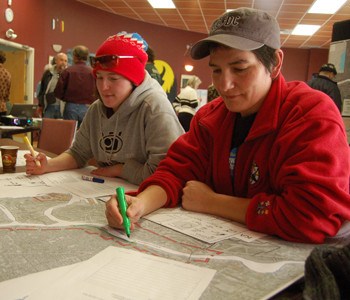First Nation members say poor communication led to a modestly attended Kam River meeting, meaning development may move forward without their participation.
The city held two recent public meetings in an effort to gain public input on what should be done with a stretch of land near the Kaministiqua River. A study by the city, partnered with Fort William First Nations, inventoried the land in question and now its authors want to know what the landscape should look like over the next 20 years.
The city held a public hearing at the Fort William First Nations Community Centre Saturday afternoon, the second of the two public meetings. But getting First Nations perspective for the study proved difficult as less then five Fort William First Nation members attended.
"This isn’t community engagement," said Ed Collins, an economic officer for the band who attended the meeting as a community member. "We have a news letter and if we had more time I guarantee more people from the community would have come out."
Collins said he’s concerned how the city will handle finding artifacts during the project’s development. Since the Fort William area is a traditional hunting ground, anything from arrowheads to a burial ground could be discovered in the area.
Collins said he wants more opportunities for First Nation people to get involved in development projects and hopes it will create jobs in the community.
The area the study focuses on is situated between the Mountdale Avenue boat launch and Lake Superior land on both sides of the river. That includes McKeller and Mission islands, which are being used less and less for industrial reasons. A portion of the land in question is First Nation territory.
Gail Bannon is also a Fort William First Nation member. Bannon said she believes the meeting could have had a better turnout had Fort William’s chief and council members been more involved.
"I would like to know Fort William’s input in the discussion," Bannon said. "How much of Fort William’s input is in these studies?"
Using a map provided by the city’s planning division, Bannon sketched what she would like to see done in the study area.
She said the city should keep one grain elevator in an effort to preserve the area’s history. She added that she would also like to see more commercial and recreational areas developed.
Bannon said the city could easily accomplish developing an area on the Kam River where people could skate.
Brian Ludwigsen, community consultation officer with Fort William First Nation, said the meeting’s turnout concerned him.
"Community engagement is always a huge challenge," Ludwigsen said. "It is not that our community has no interest in the Kam River studies or any other studies, it’s just…lady luck I guess."
"There is a lot of history to our land and we definitely just want to move ahead," he said.
Thora Cartlidge, land use planner with the City of Thunder Bay, said the Fort William First Nation community was invited to come to the sessions. She said the city placed posters in some public libraries, recreational areas and food shops last week. City officials also placed an ad in the local paper, and issued press releases to local media.
"Trust takes a long time to build," Cartlidge said. "This is an ongoing process. There is no concern that there are few Fort William First Nation community members."
Cartlidge added that most of the advertising was done in the south-core of the city. She admits it was a modest attempt at opening up dialogue.
Cartlidge said development with FWFN could mean an expanded settlement.
"It really needs to be remembered that we are planning out the how to. At this point, this is very much an exercise in rediscovery the region," she said.
The city held an earlier public hearing at the Thunder Bay Community Centre on Jan. 18. A cost of the project was not readily available. The final report will be present to City Council sometime this summer.
Sign in or register
- Messages
- Post a Listing
- Your Listings
- Your Profile
- Your Subscriptions
- Your Likes
- Your Business
- Support Local News
- Payment History
Registered Users
Already have an account?
New Users
Create a free account.
